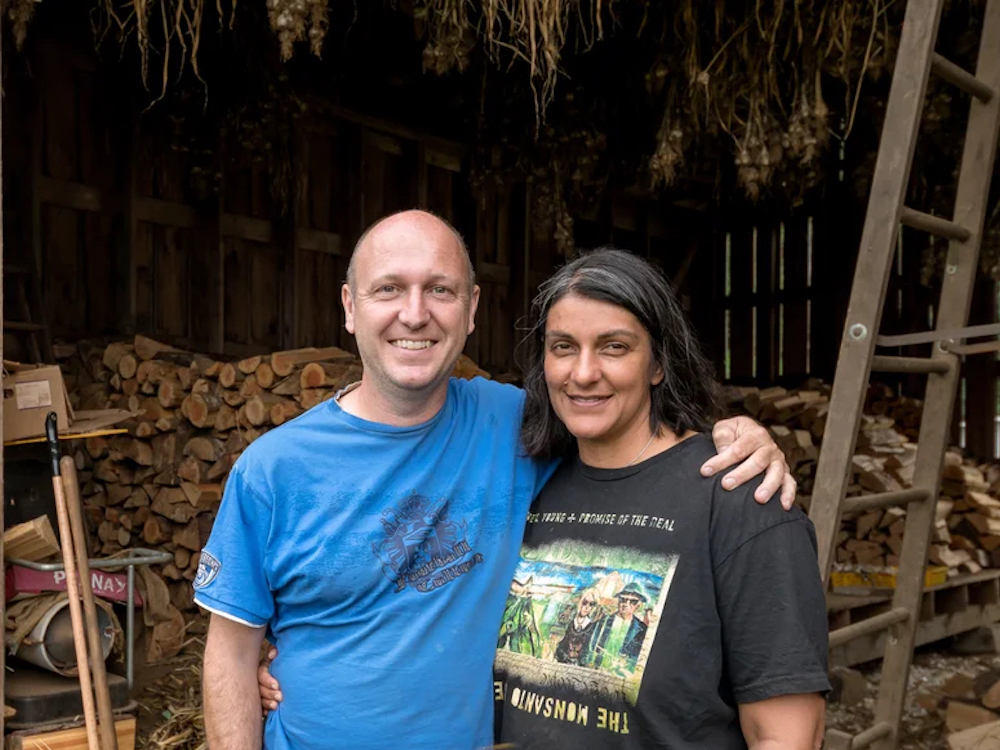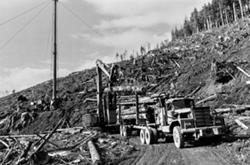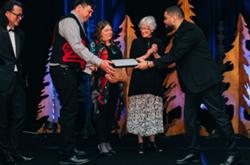Vancouver Island farmers Arzeena Hamir and her husband decided they wanted nothing to do with the British Columbia government’s mismanaged water licensing system.
Even as drought hit their 10-hectare certified organic Amara Farm hard this summer and they face destroying crops because there’s not enough water, Hamir doesn’t see joining the provincially regulated system as the answer.
“We’ve been here 12 years and I have not seen a season quite like this in terms of dryness,” she said from the farm in Grantham, between Merville and Courtenay in the Comox Valley. “We’ve always felt we were water secure and this season has just blown that out of the water.”
Water on the farm comes from a dugout that holds some 1.9 million litres captured when it rains. By mid-August there was less than a metre of water left at its bottom. “We are now looking at having to sacrifice some crops that could have gone well into the fall but we don’t have enough water to keep them going,” Hamir said. “Those are tough decisions.”
Zucchinis and tomatoes in greenhouses will likely need to be pulled. It will be a waste and lost sales, but it will allow them to keep the farm’s fruit and nut trees going.
During this summer’s drought, the provincial government has been telling farmers who are short of water, or not licensed to use it, to find places to buy it.
Amara Farm could buy water from the nearest municipal system, but the 57,000 litres they use each week would cost $600, adding an unanticipated expense, Hamir said. “It stops making financial sense, hence the sacrificing of crops before we get to that stage.”
There’s a well on the property that they use for their household’s domestic purposes, but it’s not licensed for farm use. Nor will they seek a licence for it and are instead planning to double the size of their dugout. As long as a dugout captures water before it has reached a stream, no licence is required.
“If we were going to rely on our well, we probably would have got one of these shutoff orders we’re seeing across B.C. because of this issue,” Hamir said. “When a situation like this happens, where farmers are now being pitted against each other, when farmers are being told to shut off, to stop watering from the aquifer, that made no sense to us.”
Nor is it just farmers competing for water. B.C. uses a seniority system of “first in time, first in right,” known by its acronym FITFIR, that gives priority to users based on how long they’ve been licensed, no matter what they are using the water for.
“That makes zero sense,” said Hamir.
FITFIR is fine when there’s plenty of water for everybody, said Oliver Brandes, the co-director of the POLIS Project on Ecological Governance at the University of Victoria. But “it’s very problematic when you are actually having to cut off junior licences because in many places.... the junior licences are often very important economically,” Brandes said. “Those are the wine growers, the tourism, the local organic farms.”
For a relatively new farm like Amara, there would be many other water users ahead in line who would have priority, Hamir said. “Who was able to send in their licences early? A lot of the larger farms and/or operations that are using quantities of water and have people to fill in all the forms.”
It would be more sensible, she said, to give priority to ecosystems and rivers, then make sure farms producing food have enough, before allocating water to golf courses, riding rings, water bottling and less essential uses. A water bottling operation in the area that in recent years received a licence has been particularly controversial.
“There needs to be a prioritization of food,” Hamir said. “The way that water is used in B.C., we’re now seeing just how extravagant it is.”
New water law being enforced
Under new rules introduced in 2016 under the Water Sustainability Act, anyone drawing on groundwater for purposes other than household use had to get a licence and begin paying fees. The law applies to farms both big and small, and to any businesses that draw water from a well.
With much of B.C. in severe or extreme drought this summer, the provincial government has been asking licensed water users to reduce how much they are using.
In an effort to protect salmon and trout, the province recently [effective Aug. 19] ordered some 45 surface and groundwater licence holders in the Tsolum River watershed in the Comox Valley to stop using water for forage crops like hay, alfalfa and corn for animals. Under the order farmers can still use water for market vegetables, livestock watering or domestic purposes.
A similar order had been put in place a few days earlier affecting 398 licence holders in the Salmon River and Bessette Creek areas of the Thompson Okanagan region. On Aug. 24 there was an order added covering the Koksilah and Cowichan Rivers on southern Vancouver Island.
The province has also begun cracking down on unlicensed water users. When the deadline passed in 2022 for existing commercial water users to register for the province’s new groundwater licensing system, an estimated 12,000 had failed to do so.
There are a mix of reasons. Some have told The Tyee they were aware of the need to licence but were skeptical of the government’s motives, seeing it as a “cash grab” where they would be required to pay a fee for something that had previously been free.
Others have said they heard nothing about the new system until after the deadline had passed, despite Forests Minister Bruce Ralston’s claim that the government made a substantial effort to communicate with the public about the change.
“They have screwed up and now they’re trying to blame the victim,” said one water user who didn’t hear about the deadline, missed the opportunity to get his historic use recognized and believes the government should start over by directly contacting anyone with a registered well.
But the province is not backtracking. Historic water users had six years to register after the original three-year deadline was extended an extra three years. Earlier this summer Ralston began signalling that the government is serious about enforcing the licensing system.
“Difficult decisions are made during drought and those people who… have not registered at this point will be subject to enforcement orders,” he said.
Lack of trust in Forest Ministry
Hamir said she knows of seven farms in the Comox Valley that have received orders to stop using water. While not affected directly by the enforcement, she’s watched it with concern. “My feeling is the Ministry of Forests is using the drought as the excuse to come into the community and enforce water licensing. It feels like retribution, that they’re mad that all these farmers never licensed their wells.”
Nor, in Hamir’s view, does it make sense for the Ministry of Forests to be causing suffering to farmers by restricting water use when logging that could reduce water supplies continues. “We are now being told you have to reduce your watering, but we’re still going to allow forestry up in the headwaters,” she said.
The land in the area, as on much of eastern Vancouver Island, is privately owned and the forests are managed with even fewer restrictions than they would be on public land.
“Trees and covered land absorb moisture and release it slowly over the season,” Hamir said, noting the bare spots visible on the hill up the valley from the farm. “When you have the slash techniques that forestry currently uses, that rain falls, it’s not absorbed and stored in roots, it just flows all winter long and it encourages the droughts we’re seeing right now. You’ve lost the soil water holding capacity that living forests have versus bare forest land.”
That the Forests Ministry is the lead on water licensing adds to a perception that there’s something going on beyond an interest in protecting water. The ministry’s role is generally to facilitate the sale of public goods, Hamir said. “Raw water, raw logs, same thing it feels like, and the ministry is just in the business of sale.”
She added that she finds it unavoidable to suspect that creating a market for bulk water sales was an unstated goal of the province’s new licensing system. “Unfortunately what has happened with the Water Sustainability Act is it has knowingly or unknowingly led to the commodification of our public water, of the aquifer,” she said. “Myself as a farmer I see that.”
Multiple ministries involved
That it’s strange to have the Ministry of Forests leading on water issues is a thought that’s occurred as well to UVic’s Brandes, who has been involved in water issues for decades.
“I’m just not sure the minister of forests is really the key person,” Brandes said. “It’s a government approach that’s missing. You have three ministries involved. It’s awkward in my opinion that there’s a Water Ministry and we don’t see anything from the Water Ministry.”
The government created the Ministry of Water, Land and Resource Stewardship, now headed by Stikine MLA Nathan Cullen, in 2022.
A spokesperson for the ministry said that it did anticipate a challenging drought season and worked at updating the province’s drought response plan in April. “Since April, we have been engaged with communities on drought response planning.”
During the drought the new ministry has been out of the public eye. Instead Emergency Management and Climate Readiness Minister Bowinn Ma has been at the forefront along with the forests minister. Behind the scenes staff from the Ministry of Agriculture have also been involved in discussions around water.
It becomes unclear who is doing what and who is ultimately responsible, Brandes said. “I’m worried when you start getting more than two, you get three ministries involved, you start wondering when who knew what, how often do staff know their roles and responsibilities,” he said. “I think that’s a good question to be asking in a drought.”
During this drought the government’s response has been slow, he said, even though it was predicted at least three months ago and has clearly been underway for more than a month. “That gives you a clue maybe they’re not thinking appropriately ahead of the curve to be doing the prep.”
The government should have been making decisions months ago to conserve water instead of waiting until the situation became an emergency, he said. “A lot of that water should be in the system. Stopping users now is pretty late in the game.”
Until the drought is over the government is limited in its options, but coming out of it there should be resolve to do the necessary work to prepare better for future years, Brandes said.
“We should really be thinking about how are we going to deal with drought going forward,” he said. “We should never be surprised again.… We may well come to discover that this year, very significant drought historically speaking, but compared to the future this may well become a normal.”
Effort needs to go into creating water sustainability plans, probably annually in priority areas, he said. There also needs to be a provincial drought plan that links to local efforts and builds collaborative relationships with First Nations and through regional watershed boards. “The locals in most cases have a very good handle on the kinds of solutions needed,” he said.
Important shift, poorly managed: former NDP cabinet minister
In 2016 the Water Sustainability Act was an important step forward with worthy goals, but so far the implementation has been poorly executed, said Joan Sawicki, a land-use and community sustainability consultant who served as Speaker and the minister of environment, lands and parks in NDP governments in the 1990s.
“There were many compromises, but it signalled a shift away from sector-based thinking to recognizing that, by its very nature, water demands integrated management on a watershed basis,” she said in an email.
The Water Sustainability Act was intended to update the province’s strategy for protecting, managing and using water. It allows the government to allocate water use so that streams and aquifers can be managed to keep them sustainable, not just for people and businesses who use the water, but for fish and other wildlife that depend on having enough.
Groundwater licensing was a key step towards tracking who is using how much and for what, necessary information so the government can manage water sustainably, Sawicki said. “Now, six years down the line, clearly, implementation of this key initiative has thus far been a failure.”
It’s possible to blame the government for failing to make it a priority, as well as water users for failing to pay attention and apply, she said.
But there’s a deeper problem that led to the failure and that needs to be resolved, Sawicki said. “In my opinion, a root cause of this failure is that water continues to be scattered across too many ministries. Decision-making doesn’t reflect the inherent nature of water and therefore can’t deliver on the objectives of the WSA.”
For a time there was hope that the new Ministry of Water, Land and Resource Stewardship would be the fix, she said. “But, if integrative things are happening, it’s not evident yet.” Some of the policy work moved to the new ministry, but decisions about allocation, such as the groundwater licensing system, were left in forests. “How does that make sense to anyone?”
It’s a “structural disconnect” that the government needs to address, said Sawicki. “The most immediate need is to appoint ‘someone’ to take comprehensive charge of the groundwater licensing mess. But that is just the tip of the iceberg. There needs to one minister/agency with the clear mandate and responsibility to co-ordinate decisions across ministries to ensure water sustainability.”
There’s a limited amount of water and it’s essential for human health and safety, fish and ecosystem health, economic development, community resilience and Indigenous reconciliation, she said. “It’s all the same water — and it is under increasing stress,” she said. “That won’t change. So our management structures must.”
A spokesperson for the Water Ministry said it led the development of the drought response plan that guides the actions that the Forests Ministry and the Emergency Management and Climate Readiness Ministry are now taking.
“The current focus of the Ministry of Water, Land and Resource Stewardship’s work is to support cross-ministry work to step up provincial action in response to drought and longer-term planning, and to ensure alignment with the Ministry of Forests, the Ministry of Forests-led regional response teams, Ministry of Emergency Management and Rlimate readiness, the Ministry of Agriculture and Food and other ministries as required,” they said.
Much work has been underway over the past few years to better protect B.C.’s watersheds and ecosystems, and there’s more to come, they said. “Recognizing climate change, the ministry will work with [other] ministries, First Nations and partners to continue developing longer-term drought actions that focus on preparedness, mitigation and response.”
Brandes at UVic said leadership is needed and the work to better manage water is long overdue. “We haven’t got there yet,” he said. “We’re seven years into the new act and I think we’ve got to hit turbo boost here because the weather isn’t going to get any easier.”
On Amara Farm, the focus is on getting through the current drought before doing what they can to prepare themselves for the future.
There are still weeks to go in the growing season and rain is unlikely to arrive soon enough, Hamir said. “It’s only August and we don’t normally start getting rains until late September, early October. This is only going to get worse and it’s really, really scary.”
The government needs to treat the drought as the crisis that it is, she said. In other crises officials tend to show up offering assurance that they are there to help. With some exceptions, like the Agriculture Ministry’s efforts to help secure feed for livestock, that hasn’t been the case for farmers during the drought, she said. “We seem to be getting punitive things happening rather than support.” ![]()
Read more: BC Politics, Environment
















Tyee Commenting Guidelines
Comments that violate guidelines risk being deleted, and violations may result in a temporary or permanent user ban. Maintain the spirit of good conversation to stay in the discussion and be patient with moderators. Comments are reviewed regularly but not in real time.
Do:
Do not: